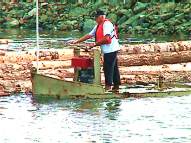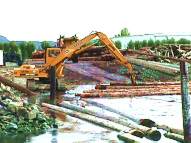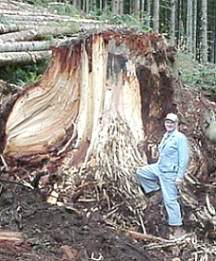Anacortes,
Washington
A picturesque
northwest town
September 13-19, 2000
Although  Laura and I
try our best not to repeat areas that we visit, the State of
Washington has got to be one of our favorites. I will have to
admit that is in summer only. Snow just holds no appeal for
either of us anymore. Anyway, we had gone through Washington in
1998 and decided that we would make a couple of stops there, this
year on our way back down from the western part of Canada.
Laura and I
try our best not to repeat areas that we visit, the State of
Washington has got to be one of our favorites. I will have to
admit that is in summer only. Snow just holds no appeal for
either of us anymore. Anyway, we had gone through Washington in
1998 and decided that we would make a couple of stops there, this
year on our way back down from the western part of Canada.
Anacortes is one of those small towns on the Pacific located in
the northwestern part of Washington. We had gone through this
area on our way to Port Townsend in 1998. This time we decided to
spend a little time there and see what was there to see. In the
town we wandered around and looked at the beautiful marina with
all of its lovely boats. Many of them were sailboats which are my favorites. Then we saw a restaurant called Randy's
Pier 61 (excellent food and fantastic view). On our way to the
restaurant we stopped to look at the lumber yard located next
door. I have often seen the huge piles of logs stacked up in
these lumber yards but had never seen workers unloading them from
the water. Well, the operation was certainly interesting. One
person in a small boat
which are my favorites. Then we saw a restaurant called Randy's
Pier 61 (excellent food and fantastic view). On our way to the
restaurant we stopped to look at the lumber yard located next
door. I have often seen the huge piles of logs stacked up in
these lumber yards but had never seen workers unloading them from
the water. Well, the operation was certainly interesting. One
person in a small boat  would push the logs that were chained together
into the inlet in the lumber yard. Then another man operated a
very strange looking boat which was powered by a small outboard
motor and could be easy turned in any direction and pushed the
logs closer to the shore. The next operator would pick up the
logs with a large claw-like device and move them onto the shore
where other operators driving fork-lift trucks would take them to
there final location in the yard.
would push the logs that were chained together
into the inlet in the lumber yard. Then another man operated a
very strange looking boat which was powered by a small outboard
motor and could be easy turned in any direction and pushed the
logs closer to the shore. The next operator would pick up the
logs with a large claw-like device and move them onto the shore
where other operators driving fork-lift trucks would take them to
there final location in the yard.  It was fascinating to watch them move these
heavy cumbersome logs like they were matchsticks. I think what
made it more interesting was the fact that we have a friend who
builds roads for logging companies in Washington. He took us on a
tour of one of the logging operations in Washington and showed us
how the logs were cut down and trucked out. The picture on the
right shows our friend, Lynn Davis, next to a stump he removed in
order to get the road where it needed to go.
It was fascinating to watch them move these
heavy cumbersome logs like they were matchsticks. I think what
made it more interesting was the fact that we have a friend who
builds roads for logging companies in Washington. He took us on a
tour of one of the logging operations in Washington and showed us
how the logs were cut down and trucked out. The picture on the
right shows our friend, Lynn Davis, next to a stump he removed in
order to get the road where it needed to go.
On Sunday we wandered down to the center of town for our weekly
brunch and found an old time steam engine show, or gathering.
These impromptu, come as you are and bring something interesting
gatherings can be delightful to the engineering mind or anybody
else with mechanical interests. Here,  to be sure, are the old one and two cylinder
steam engines of years gone past. Late 1800s and early 1900s seem
to have been the best for creation. What a time that must have
been. There is always some unusual and intriguing machine which
neither runs well or quits. Although billed as a steam engine
show, early internal combustion machines are welcome if they are
authentic and old. Of particular interest to me were the ones
that fell into the group or category known as "hit or
miss" engines. One cylinder which only fires ever
to be sure, are the old one and two cylinder
steam engines of years gone past. Late 1800s and early 1900s seem
to have been the best for creation. What a time that must have
been. There is always some unusual and intriguing machine which
neither runs well or quits. Although billed as a steam engine
show, early internal combustion machines are welcome if they are
authentic and old. Of particular interest to me were the ones
that fell into the group or category known as "hit or
miss" engines. One cylinder which only fires ever  3,
4 or maybe 6 strokes of the piston, allowing a heavy fly wheel to
carry the machine through the other revolutions. Two items of
notable mention were: first, a gear box in which a half cog, like a
crescent moon, was used with the driving gear running over the
top of the cog then under it causing the drive shaft to reverse
direction. It is hard to describe but fascinating to watch in
action. It was used in a 1902 washing machine sold by Sears. The
second one was a machine which simply defied understanding
without an explanation. A relatively newcomer to the machine age,
known simply as the "Banks Machine", the machine was
invented by a
3,
4 or maybe 6 strokes of the piston, allowing a heavy fly wheel to
carry the machine through the other revolutions. Two items of
notable mention were: first, a gear box in which a half cog, like a
crescent moon, was used with the driving gear running over the
top of the cog then under it causing the drive shaft to reverse
direction. It is hard to describe but fascinating to watch in
action. It was used in a 1902 washing machine sold by Sears. The
second one was a machine which simply defied understanding
without an explanation. A relatively newcomer to the machine age,
known simply as the "Banks Machine", the machine was
invented by a  young physicist named Ridgeway Banks at Berkley
in 1973. The working model was given to Edwin McMillan, then
director of the Lawrence Radiation for saying "Go ahead try
it", when Ridgeway came to him with the idea. The idea was
to harness the property of a somewhat unknown metal called
Niobium whose unusual property when made into a wire is that the
wire will bend when hot and straighten out when cool. By making a
wheel with many of these wires hanging underneath suspended on
sliding rods, the rod would move when the wire was passed from
warm water to cool water. By allowing the moving rod to exert its
force against a gear, motion was created. It was the dandiest thing I had seen to watch it run. So the week had its interest
and its intriguing moments.
young physicist named Ridgeway Banks at Berkley
in 1973. The working model was given to Edwin McMillan, then
director of the Lawrence Radiation for saying "Go ahead try
it", when Ridgeway came to him with the idea. The idea was
to harness the property of a somewhat unknown metal called
Niobium whose unusual property when made into a wire is that the
wire will bend when hot and straighten out when cool. By making a
wheel with many of these wires hanging underneath suspended on
sliding rods, the rod would move when the wire was passed from
warm water to cool water. By allowing the moving rod to exert its
force against a gear, motion was created. It was the dandiest thing I had seen to watch it run. So the week had its interest
and its intriguing moments.
* * * THE END * * *
